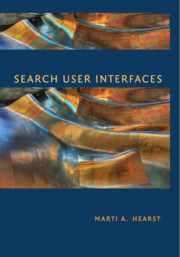Book contents
- Frontmatter
- Contents
- Preface
- 1 The Design of Search User Interfaces
- 2 The Evaluation of Search User Interfaces
- 3 Models of the Information Seeking Process
- 4 Query Specification
- 5 Presentation of Search Results
- 6 Query Reformulation
- 7 Supporting the Search Process
- 8 Integrating Navigation with Search
- 9 Personalization in Search
- 10 Information Visualization for Search Interfaces
- 11 Information Visualization for Text Analysis
- 12 Emerging Trends in Search Interfaces
- Appendix: Additional Copyright Notices
- Bibliography
- Index
- Author Index
- Plate section
11 - Information Visualization for Text Analysis
Published online by Cambridge University Press: 05 March 2013
- Frontmatter
- Contents
- Preface
- 1 The Design of Search User Interfaces
- 2 The Evaluation of Search User Interfaces
- 3 Models of the Information Seeking Process
- 4 Query Specification
- 5 Presentation of Search Results
- 6 Query Reformulation
- 7 Supporting the Search Process
- 8 Integrating Navigation with Search
- 9 Personalization in Search
- 10 Information Visualization for Search Interfaces
- 11 Information Visualization for Text Analysis
- 12 Emerging Trends in Search Interfaces
- Appendix: Additional Copyright Notices
- Bibliography
- Index
- Author Index
- Plate section
Summary
As discussed in the previous chapter, visualization when applied to text seems to be most effective for specialists doing data analysis. Although this is an exciting field, it is not what most people think of when one talks about search interfaces. Unfortunately, some researchers working on visualization of text conflate search tasks with data analysis tasks. For example, Veerasamy and Heikes (1997) critique one interface for making it “more difficult than in our tool to gain an overall picture of the query word distribution for a whole set of documents in one glance.” It is unclear why a searcher would want to see such a distribution, even though such a view may be of great interest to a computational linguist.
This chapter describes ideas that have been put forward for understanding the contents of text collections from a more analytical point of view. The first section discusses applications in the field of Text Mining, which usually involve visualizing connections among entities within and across documents. The next section discusses methods for visualization occurrences of words or phrases within documents, in what have classically been called concordances. The final section discusses various attempts to visualize relationships between words in their usage in language and in lexical ontologies.
Visualization for Text Mining
There is great interest in the field of text mining, which can be defined as the discovery by computer of new, previously unknown information, by automatically extracting information from different written resources (Feldman and Sanger 2006; Hearst 1999a).
Information
- Type
- Chapter
- Information
- Search User Interfaces , pp. 281 - 296Publisher: Cambridge University PressPrint publication year: 2009
Accessibility standard: Unknown
Why this information is here
This section outlines the accessibility features of this content - including support for screen readers, full keyboard navigation and high-contrast display options. This may not be relevant for you.Accessibility Information
- 1
- Cited by
